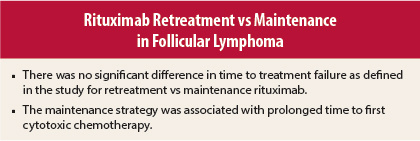Maintenance rituximab (Rituxan) has been shown to improve progression-free survival vs observation in low–tumor burden follicular lymphoma. In the Eastern Cooperative Oncology Group (ECOG) E4402 Trial (RESORT), reported in the Journal of Clinical Oncology, Brad S. Kahl, MD, of the University of Wisconsin School of Medicine and Public Health, Madison, and colleagues found no significant difference in time to treatment failure with a strategy of rituximab retreatment at progression vs rituximab maintenance in patients with previously untreated low–tumor burden follicular lymphoma.1 The maintenance strategy was associated with longer time to first cytotoxic chemotherapy, and the retreatment strategy required less use of rituximab.
Study Details
In the trial, 408 patients with previously untreated low–tumor burden follicular lymphoma received four weekly doses of rituximab at 375 mg/m2. Those with a complete or partial response at week 13 (n = 289) were randomly assigned to rituximab maintenance (n = 146) or retreatment (n = 143).
Rituximab maintenance consisted of a single dose of rituximab every 3 months until treatment failure. Any progressive disease between scheduled maintenance rituximab doses constituted treatment failure.
Rituximab retreatment consisted of retreatment at each disease progression until treatment failure. Treatment failure was defined as no response to retreatment rituximab, time to progression < 26 weeks, initiation of alternative therapy, or inability to complete planned therapy.
Patients were evaluated every 13 weeks and underwent repeat computed tomography scans every 26 weeks. The primary endpoint was time to treatment failure.
The retreatment and maintenance groups were generally balanced for age (median, 60 and 59 years), sex (53% and 55% female), race (94% and 95% white), Eastern Cooperative Oncology Group (ECOG) performance status (0 in 84% and 88%), bone marrow involvement (43% and 50%), elevated lactate dehydrogenase (13% and 15%), elevated β2-microglobulin (46% and 38%), stage (III in 55% and 46%, IV in 44% and 53%), Follicular Lymphoma International Prognostic Index (FLIPI) score (low in 15% and 16%, intermediate in 45% in both, high in 40% and 39%), histology grade (1 in 71% and 66%, 2 in 23% and 29%, 3a in 2% and 1%), and time from diagnosis < 1 year (92% and 90%).
Overall, the complete response/unconfirmed complete response rate during initial rituximab treatment was 11.8%, with no difference between the randomized groups. The investigators noted that this rate was lower than expected likely due to missing repeat bone marrow assessments.
Of 120 patients with partial response who were assigned to rituximab retreatment, 41% converted to complete response/unconfirmed complete response with either no further treatment (24%) or with retreatment at progression (17%). Of 113 patients with a partial response who were assigned to maintenance rituximab, 51% converted to complete response/unconfirmed complete response during maintenance therapy.
Time to Treatment Failure
After a median follow-up of 4.5 years, there were 80 treatment failures in the retreatment group and 78 in the maintenance group. Median time to treatment failure was 3.9 vs 4.3 years (P = .54), with 61% vs 64% of patients remaining free of treatment failure at 3 years (P = .33).
There was no difference in risk for treatment failure according to retreatment vs maintenance on multivariate analysis (hazard ratio [HR] = 1.07, P = .68). On multivariate analysis, the only significant predictor of treatment failure was intermediate vs low FLIPI score (HR = 1.71, P = .04).
Reasons for treatment failure included rituximab resistance in 26% of the retreatment group vs 21% of the maintenance group, need for initiation of alternative treatment in 10% vs 1%, and inability to complete planned therapy in 16% vs 30%. Among those who could not complete planned therapy, reasons were toxicity, death, or other disease in 5% vs 13% and withdrawal for reasons other than toxicity (eg, patient tired of study commitment) in 11% vs 17%.
In a sensitivity analysis censoring patient withdrawals for nonmedical reasons, the estimated treatment failure–free survival was 65% vs 73% at 3 years (P = .16) and 50% vs 53% at 5 years.
Other Outcomes
As expected, more patients in the maintenance group were progression-free at 3 years (50% vs 78%). In the retreatment group, median duration of response was 34.4 months to induction treatment, 18.5 months in 34 of 56 patents responding to first retreatment, and 12 months in 8 of 12 with response to second retreatment. No response was observed in four patients receiving third retreatment.
There were few deaths, and overall survival did not differ between groups (94% vs 94% at 5 years). Rates of freedom from cytotoxic chemotherapy were 84% vs 95% (P = .03) at 3 years and 80% vs 92% at 5 years.
Including the four induction doses, the median number of rituximab doses was four (range, 4–16) in the retreatment group and 18 (range, 5–35) in the maintenance group. There were no differences in health-related quality of life or anxiety between the two groups.
Toxicity
Grade ≥ 3 adverse events were infrequent in both groups. Four grade 3 events occurred in retreatment patients, and 10 occurred in maintenance patients; two grade 4 events occurred in retreatment patients, and one grade 5 event occurred in a maintenance patient.
The investigators concluded:
There was a small advantage for [maintenance rituximab] in time to first cytotoxic therapy, but significantly more rituximab was required to achieve this benefit. This trial has implications for both research and practice. With regard to research, it would be highly interesting to determine if a [retreatment] strategy could produce outcomes comparable to those of a [maintenance] strategy, when applied after rituximab plus chemotherapy in high–tumor burden [follicular lymphoma]. Given the widespread use of [maintenance rituximab], the resource use implications are large. With regard to practice, RESORT indicates that if opting for single-agent rituximab as initial therapy for low–tumor burden [follicular lymphoma], a strategy of retreatment at disease progression is recommended over a strategy of continuous maintenance therapy. ■
Disclosure: The study was supported by grants from the National Cancer Institute, National Institutes of Health, and Department of Health and Human Services. For full disclosures of the study authors, visit jco.ascopubs.org.
Reference
1. Kahl BS, Hong F, Williams ME, et al: Rituximab extended schedule or re-treatment trial for low–tumor burden follicular lymphoma: Eastern Cooperative Oncology Group Protocol E4402. J Clin Oncol. August 25, 2014 (early release online).



